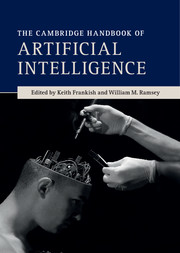Book contents
- Frontmatter
- Contents
- List of figures
- Notes on contributors
- Acknowledgments
- Introduction
- Part I Foundations
- Part II Architectures
- Part III Dimensions
- 7 Learning
- 8 Perception and computer vision
- 9 Reasoning and decision making
- 10 Language and communication
- 11 Actions and agents
- 12 Artificial emotions and machine consciousness
- Part IV Extensions
- Glossary
- Index
- References
11 - Actions and agents
Published online by Cambridge University Press: 05 July 2014
- Frontmatter
- Contents
- List of figures
- Notes on contributors
- Acknowledgments
- Introduction
- Part I Foundations
- Part II Architectures
- Part III Dimensions
- 7 Learning
- 8 Perception and computer vision
- 9 Reasoning and decision making
- 10 Language and communication
- 11 Actions and agents
- 12 Artificial emotions and machine consciousness
- Part IV Extensions
- Glossary
- Index
- References
Summary
Introduction
Classical artificial intelligence (AI) approaches to action tended to focus on single, isolated software systems that acted in a relatively inflexible way, automatically following pre-set rules. However, new technologies and software applications have created a need for artificial entities that are more autonomous, flexible, and adaptive, and that operate as social entities in multi-agent systems. This chapter introduces and surveys this emerging agent-centered AI and highlights the importance of developing theories of action, learning, and negotiation in multi-agent scenarios such as the internet.
Action in AI
Historically, the “Physical Symbol System Hypothesis” in AI (Newell and Simon 1976) has been embedded in so-called deliberative systems. Such systems are characterized by containing symbolic models of the world, and decisions about which actions to perform are made via manipulation of these symbols. To get an AI system to “act” it is enough to give it a logical representation of a theory of action (how systems make decisions and act accordingly) and get it to do a bit of theorem proving.
Keywords
- Type
- Chapter
- Information
- The Cambridge Handbook of Artificial Intelligence , pp. 232 - 246Publisher: Cambridge University PressPrint publication year: 2014
References
- 9
- Cited by

